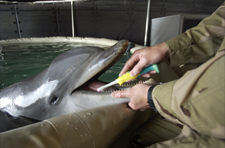|
UMM QASR, Iraq — One of the stars of the joint effort to locate underwater mines near the Iraqi seaport targeted to receive humanitarian supplies during the current war is a 33-year-old veteran whose battle scars are testament to his willingness to do the tough jobs.
When he’s in the mood.
But he’s a dolphin. An Atlantic bottlenose dolphin. So cut him a little slack. He’s good, handlers say, at what he does: finding mines and even placing demolition charges close enough to set them off.
“Basically, he’ll work as long as his attitude feels up to it,” said Signalman 2nd Class (DV) Bud Bickford, 28, of San Diego, Makai’s primary handler, as he stroked Makai’s forehead in the circular pool serving as his home in an abandoned warehouse at Umm Qasr.
Makai is one of two male dolphins here — the other is named Tacoma — who are part of a team of hands-on mine detectors known as Naval Special Clearance Team 1. Another seven dolphins remain in special holding pools on board the landing ship dock Gunston Hall, the team’s floating support base.
The remaining team members are human: Navy explosive ordnance disposal specialists, who handle the dolphins, and Navy SEALs, Force Recon Marines, and British and Australian divers.
This deployment marks the first time these dolphins have been deployed to a war in a search for mines, according to Capt. Mike Butler, a Force Recon Marine and the acting operations officer for NSCT 1.
The dolphins find mines using what is termed “eco-location,” their natural sonar which, according to Aviation Ordnanceman 1st Class (EOD/AW) Dee Jennings, 33, of Shetfield, Texas, a member of Naval Special Clearance Team 1, “is better than anything man could ever make.”
During a search, the handler remains in a boat and communicates with the dolphin using hand signals. “You’re moving him toward the area you want to have the animal search,” said Senior Chief Boatswain’s Mate (EOD) Woody Carr, of Indianapolis, the senior operations chief for NSCT 1. “If he gives you a positive, you mark it electronically, and you move on until all your tracks are done.”
The dolphins also can mark a suspected mine with a transponder.
Divers generally drop the anti-mine charges, but a dolphin also can deliver a 26-pound charge in the vicinity of the mine, using a nose cone, before scurrying back to his handler.
Jennings said the dolphins are trained for about 10 years on how to find targets, using a reward system somewhat like that used to train police dogs. “Whenever they get it in the parameters that we wanted, they get rewarded,” Jennings said. “It’s all based on positive reinforcement.”
Top
|
